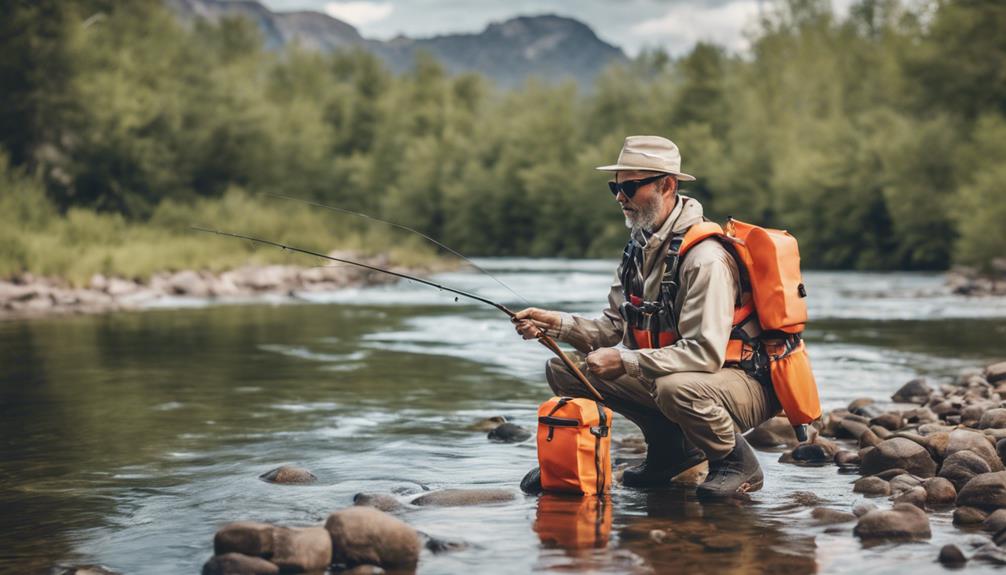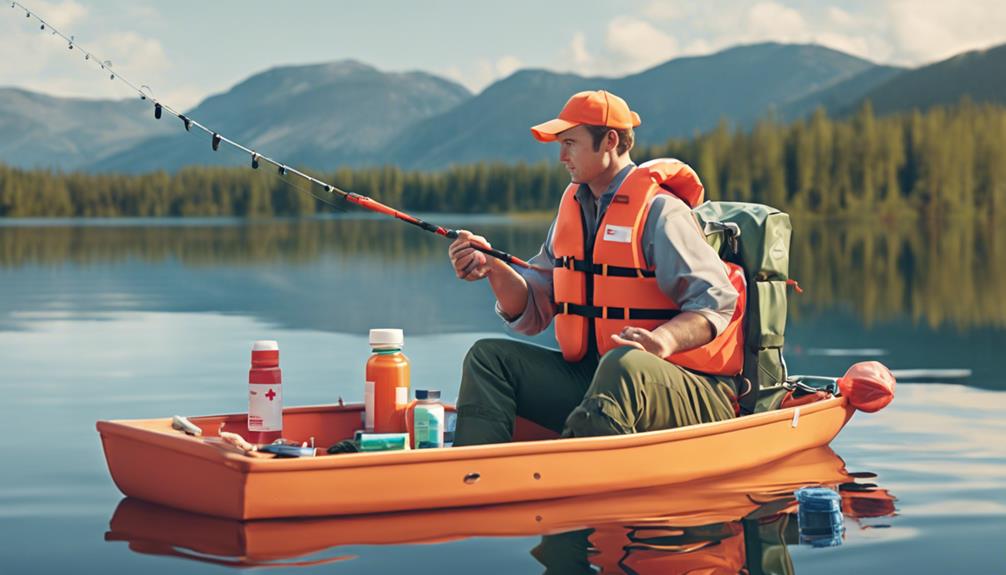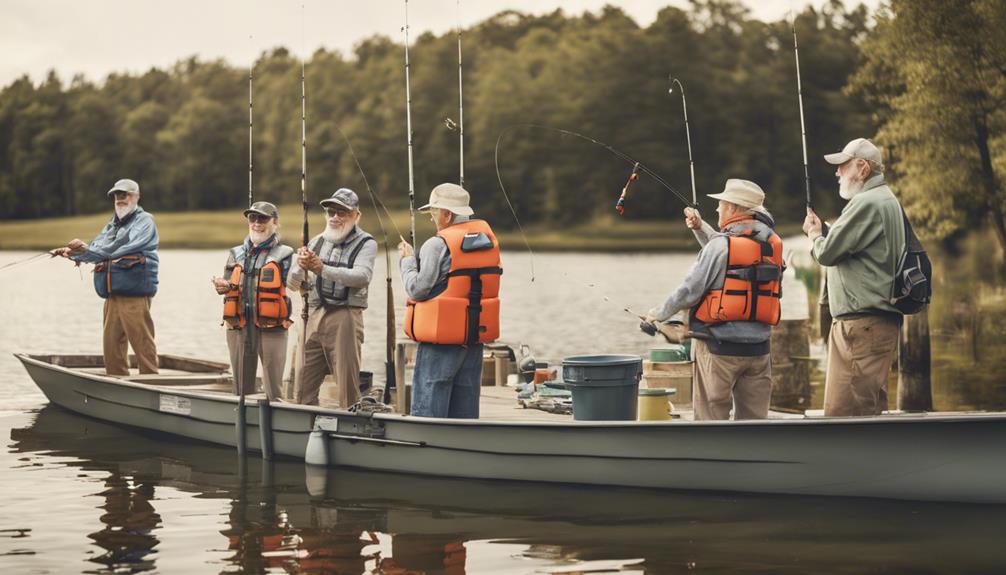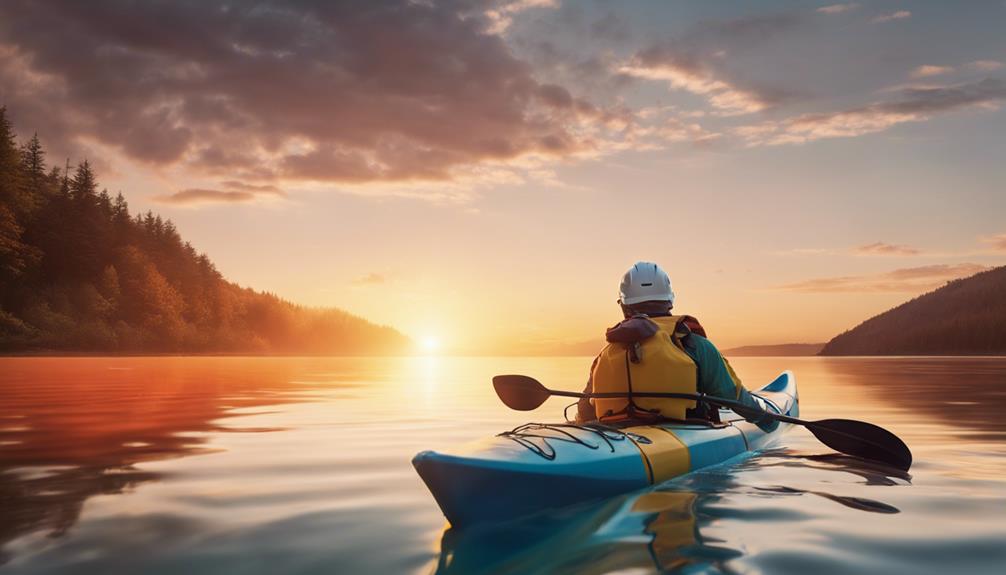Did you know that according to the U.S. Coast Guard, approximately 80% of fatal boating accident victims drowned, and about 83% of those victims were not wearing a life jacket?
Ensuring safety in fly fishing is paramount for a variety of reasons that go beyond just the statistics. Your well-being and the well-being of those around you are at stake, making it crucial to prioritize safety measures.
Importance of Safety Measures
Prioritizing safety in fly fishing requires vigilance and adherence to essential safety measures to ensure a successful and enjoyable experience on the water. The importance of safety measures can't be overstated when engaging in this exhilarating activity. By taking necessary precautions, maintaining awareness of your surroundings, and focusing on prevention, you can significantly reduce the risks associated with fly fishing.
The importance of safety measures lies in safeguarding both yourself and others. By following essential precautions such as wearing proper gear, checking weather conditions, and being mindful of your casting technique, you can minimize the likelihood of accidents or injuries. Being aware of potential hazards such as slippery rocks, fast currents, or overhanging branches is key to staying safe while fly fishing.
Prevention is key to a successful fly fishing outing. By taking proactive steps such as learning proper casting techniques, practicing catch and release methods responsibly, and understanding how to handle fish safely, you can prevent accidents before they occur. Additionally, being prepared with basic first aid knowledge and carrying essential safety equipment can make a significant difference in emergency situations.
Proper Gear for Protection
Ensuring your safety while fly fishing starts with choosing the proper gear for protection against potential hazards on the water. Protective clothing plays a crucial role in safeguarding you during your fishing adventures. Opt for clothing made of quick-drying materials that provide sun protection, such as long-sleeved shirts, wide-brimmed hats, and UV-blocking sunglasses. Wearing appropriate footwear with good grip can prevent slips on slippery surfaces like rocks or mossy riverbanks. Additionally, consider investing in a quality pair of water-resistant waders to keep you dry and warm in colder waters.
In addition to protective clothing, having the right safety equipment is essential for your well-being while fly fishing. A properly fitting personal flotation device (PFD) is a must-have, especially when wading in swift currents or fishing from a boat. Make sure your PFD is approved by relevant safety authorities and worn correctly at all times. Carrying a first aid kit is also crucial in case of minor injuries or emergencies while you're out on the water. Additionally, consider packing a whistle to signal for help if needed.
Weather Awareness and Preparedness
When fly fishing, being aware of weather conditions and preparing accordingly is crucial for your safety and enjoyment on the water. Weather hazards can quickly turn a peaceful fishing trip into a dangerous situation, so it's essential to stay informed and have safety protocols in place for your outdoor adventures.
Before heading out, always check the weather forecast for the day. Keep an eye out for any potential storms, high winds, or extreme temperatures that could pose risks. It's also a good idea to bring along emergency shelters such as a lightweight tarp or a portable tent in case you need to seek refuge quickly.
As you plan your fly fishing excursion, make sure to pack appropriate clothing for the expected weather conditions. Dressing in layers is key to staying comfortable and safe throughout the day. Additionally, remember to bring along any necessary gear like a waterproof jacket, extra socks, and a hat to protect yourself from the elements.
In the event that weather conditions worsen unexpectedly, have a plan in place to safely retreat from the water. Know the quickest route to shore or a designated safe area where you can wait out the storm. By prioritizing weather awareness and preparedness, you can ensure a safer and more enjoyable fly fishing experience.
Understanding Water Conditions
To navigate safely and effectively while fly fishing, understanding water conditions is paramount. Current analysis is crucial for assessing the speed and direction of the water flow, which can impact your positioning and casting accuracy. River hazards such as submerged rocks, strong currents, and deep holes pose risks to anglers, making it essential to be aware of these dangers to avoid accidents.
When analyzing water conditions, pay close attention to the water flow. Understanding how the water moves in a river or stream can help you anticipate where fish are likely to be located and how to position yourself strategically. Additionally, being aware of the water flow can assist in identifying potential areas of turbulence or undertows where caution is warranted.
To ensure safety while fly fishing, it's vital to take appropriate safety precautions. Always wear a personal flotation device (PFD) when wading in rivers or streams with swift currents. Keep a safe distance from strong currents and never underestimate the power of moving water. Before entering the water, assess the depth and speed of the flow to determine if it's safe for fishing.
Emergency Response Planning
Incorporate an emergency response plan into your fly fishing outings to prioritize safety and preparedness in case of unexpected incidents. First aid knowledge is crucial when engaging in outdoor activities like fly fishing. Make sure to pack a basic first aid kit including essentials like bandages, antiseptic wipes, and pain relievers. Familiarize yourself with how to treat common injuries such as cuts, bruises, or hook accidents promptly. Additionally, consider taking a first aid course to enhance your skills and confidence in providing aid when needed.
Establishing communication protocols with your fishing companions is vital for effective emergency response planning. Before starting your fly fishing trip, agree on a communication plan in case someone gets injured or lost. Ensure everyone knows the designated meeting points and emergency contact information. It's essential to have a reliable means of communication such as cell phones or two-way radios to stay connected while on the water. Regularly check your devices' battery life and signal strength to avoid any communication breakdowns during emergencies.
Casting Safety Techniques
Prioritize your safety on the water by mastering essential casting safety techniques during your fly fishing adventures. To ensure casting accuracy and prevent injuries, it's crucial to follow specific guidelines. First and foremost, always check your surroundings before casting to avoid accidentally hooking objects or people. Make sure there's enough space behind you to execute a backcast safely. Maintaining proper distance between yourself and others is key to injury prevention.
When casting, focus on technique rather than sheer force. Smooth, controlled movements not only improve casting accuracy but also reduce the risk of straining muscles or joints. It's essential to wear appropriate eye protection to shield your eyes from any potential accidents, such as flies rebounding off the water or wind blowing debris your way. Additionally, to prevent injury, take breaks to rest your arm muscles and avoid overexertion.
Practice different casting techniques to become more versatile and adaptable to varying fishing conditions. By honing your skills, you won't only improve your casting accuracy but also minimize the chances of accidents. Remember, safety should always be your top priority when enjoying the art of fly fishing.
Wildlife Interaction Awareness
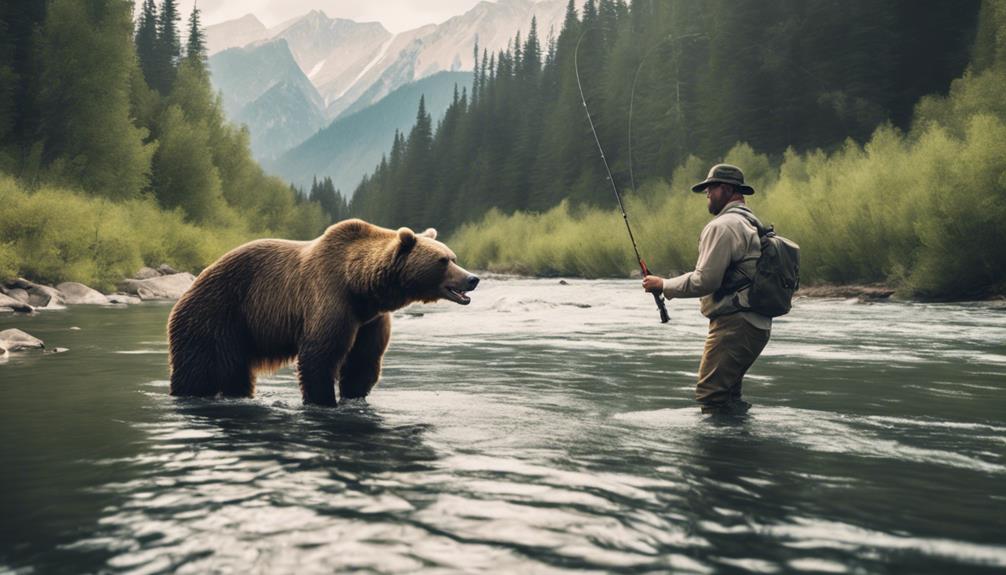
Enhance your awareness of wildlife interactions while fly fishing to ensure a harmonious coexistence with the environment. When engaging in this outdoor activity, understanding animal behavior is crucial. Wildlife, such as birds, fish, and mammals, might be disturbed by your presence. It's essential to observe their reactions to your movements and adjust accordingly to minimize stress on the animals. By being mindful of their behavior, you can prevent unnecessary disturbances and maintain a peaceful environment for both you and the wildlife.
Moreover, your actions while fly fishing can have a significant environmental impact. Littering or leaving behind fishing lines can harm wildlife through entanglement or ingestion. Always clean up after yourself and dispose of any waste properly. Additionally, be cautious with your gear to avoid accidental harm to animals. Hooks left in the water or on the ground can pose risks to wildlife if they accidentally ingest them. By being attentive to your surroundings and properly managing your equipment, you contribute to preserving the natural habitat and safeguarding the wildlife that inhabits it.
Fishing Buddy System Benefits
By partnering up with a fishing buddy, you can enhance safety and enjoyment during your fly fishing adventures. The buddy system offers numerous benefits that can make your fishing trips more secure and pleasant. Here are five key advantages to adopting this approach:
- Improved Communication: Having a fishing buddy allows for better communication strategies, ensuring that you can easily convey important information or signals to each other while on the water.
- Enhanced Safety Checks: With a buddy by your side, you can conduct more thorough safety checks before and during your fishing expedition, reducing the risk of accidents or oversights.
- Shared Knowledge: Two heads are better than one. Your fishing buddy may have different experiences and insights that can enhance your own skills and knowledge of the sport.
- Emergency Protocols: In case of any unforeseen emergencies, the buddy system provides a support system where you can rely on each other to follow established emergency protocols and assist if needed.
- Enjoyable Company: Fly fishing isn't just about catching fish; it's also about enjoying the experience. Having a buddy to share the highs and lows of fishing can significantly enhance the overall enjoyment of the trip.
Partnering up with a fishing buddy can't only make your fly fishing adventures safer but also more fulfilling.
Frequently Asked Questions
What Are Some Common Injuries That Can Occur While Fly Fishing and How Can They Be Prevented?
When fly fishing, common injuries include hook accidents and falls. To prevent these, always be aware of your surroundings and practice proper casting techniques. Stay safe by wearing appropriate gear and knowing emergency response procedures.
Water safety is crucial; wear a life jacket and avoid wading in risky areas. Remember, prioritizing safety ensures a more enjoyable fishing experience without unnecessary accidents.
Are There Any Specific Regulations or Guidelines to Follow While Fly Fishing to Ensure Safety?
When fly fishing, it's essential to follow water safety guidelines and be familiar with emergency procedures. Before you cast your line, make sure to assess risks and comply with regulations. Always wear a life jacket, especially in swift currents.
Keep a first aid kit handy and know how to use it. Stay informed about local fishing laws and restrictions to ensure a safe and enjoyable angling experience.
How Often Should Safety Equipment Be Checked and Replaced When Fly Fishing?
When fly fishing, it's crucial to check your safety equipment regularly. Make it a habit to inspect your gear before each outing to ensure everything is in good working order.
Follow a maintenance schedule recommended by the manufacturer to replace any worn-out or damaged items promptly. By staying on top of checking equipment, you can fish with peace of mind knowing you're prepared for any situation that may arise on the water.
What Are Some Signs to Look Out for to Know When It's Unsafe to Continue Fly Fishing?
If you notice sudden changes in weather conditions like dark clouds or strong winds, or if water currents become unpredictable or swift, it may be unsafe to continue fly fishing.
Always pay attention to these signs for your safety. Ensure you have proper safety gear like life jackets and know emergency signals in case of danger.
Prioritizing safety is crucial to enjoy fly fishing responsibly.
Are There Any Specific First Aid Techniques or Procedures to Be Aware of in Case of an Emergency While Fly Fishing?
In case of an emergency while fly fishing, it's crucial to know Basic CPR and wound care. Be prepared for emergency response and familiar with water safety procedures.
These skills can make a huge difference in critical situations. Remember, staying calm and acting swiftly can help prevent further harm and ensure the best possible outcome for anyone in need.
Your preparedness and quick actions can save lives while enjoying the sport.
Conclusion
Prioritize safety in fly fishing to ensure a successful and enjoyable experience on the water. By taking necessary precautions, such as wearing proper gear, being aware of weather conditions, and practicing casting safety techniques, you can prevent accidents and injuries.
Remember to always have an emergency response plan in place and consider fishing with a buddy for added safety.
Stay safe, have fun, and make the most of your fly fishing adventures!
